In tutorial HX-0022, you learned how to create a mesh manually. In this tutorial, you will learn how to create mesh for a solid profile using the Extrusion Wizard.
The model files for this tutorial are located in the file mfs-1.zip in the subdirectory \hx\MetalExtrusion\HX_0101. See Accessing Model Files.
To work on this tutorial, it is recommended that you copy this folder to your local hard drive where you store your HyperXtrude data; please refer to the tutorial HX-0004 for more details on how you can accomplish this with the Project Browser. This will enable you to edit and modify these files without affecting the original data. In addition, it is best to keep the data on a local disk attached to the machine to improve the I/O performance of the software
| 1. | From the Start menu select: All Programs > Altair > HyperXtrude to launch the HyperXtrude user interface. The User Profiles dialog appears with Manufacturing Solutions as the default application. |
| 2. | Select HyperXtrude and Metal Extrusion. |
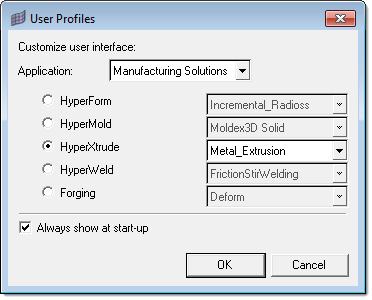
|
| 1. | From the File menu, select Open.... |
| 2. | Browse to the file HX_0101.hm and click Open. |
This model has two components - Billet and Bearing. There is a shared surface between Billet and Bearing so you do not have to create a shared surface. This can be verified by selecting Solids panel from the main menu. While in the Solids panel, you can see a shared surface between the Billet and the Bearing.
| 4. | Inspect the model for any issues with the surfaces. Since this model is clean, you can go ahead with the next step. |
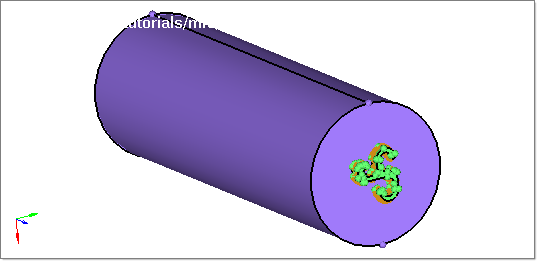
|
| 1. | On the Utility menu, click Extrusion Wizard. Depending on how you loaded the model, the Project Browser prompt you for action (see HX-0004 for details). |
| 2. | In the Extrusion Wizard, click the Set Model Units checkbox. |
Note: Measure dimensions of the model (ex: diameter of the billet) by pressing F4 button on the key board. Find the distance between any two nodes lying diagonally opposite to each other on the circumference of the billet. The numerical value of this distance (the diameter of the billet) gives you an idea about the unit system in which the model is created.
In the present model, the billet diameter is about 6.62. Hence, it is reasonable to conclude that the length unit of the present model is ‘inches’. (6.62 mm diameter billets are practically not used in extrusion).
| 3. | Set the unit system to British and click OK. |
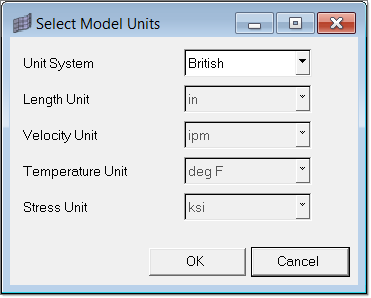
|
| 1. | Click Set Analysis Requirements. The Process Data dialog opens. |
| 2. | Set the options as shown in the image below and click Next. |
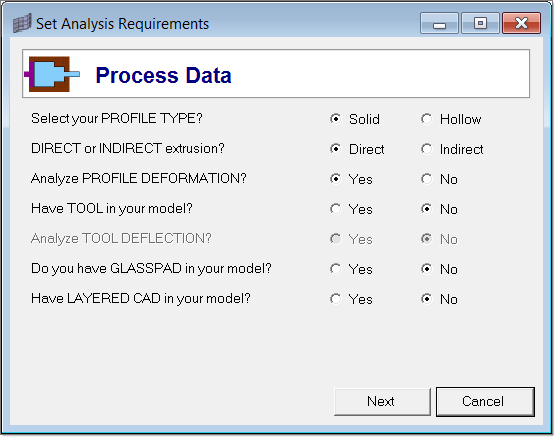
| 3. | In the Analysis Data dialog, set the parameters as shown below and click Next. |
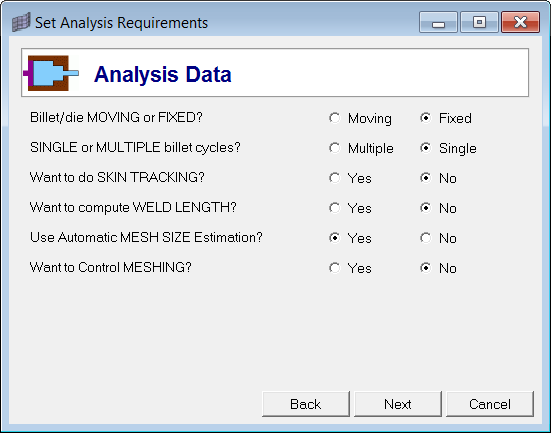
| 4. | In the Select Extrusion Components dialog, notice Billet, Bearing Cavity and Profile are recognized and pre-selected. |
|
| 1. | Click Select Material Data. |
| 2. | Expand Workpiece, then expand Aluminum_Alloys and expand 6000_Series. |
| 3. | Select AA6063 and click Add to add the material under Selected Materials. |
You do not need to assign a material in the Extrusion Wizard. The selected material will be assigned to the workpiece automatically.
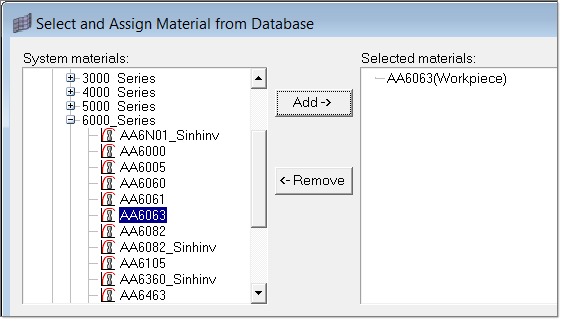
|
| 1. | Click Generate Workpiece Mesh. Notice that the Extrusion Wizard already picked the components for Billet and Bearing. |
Note: Please always rename the components by proper names so that the Extrusion Wizard identifies the components by default.
| 2. | Input the size of the elements as shown below. |
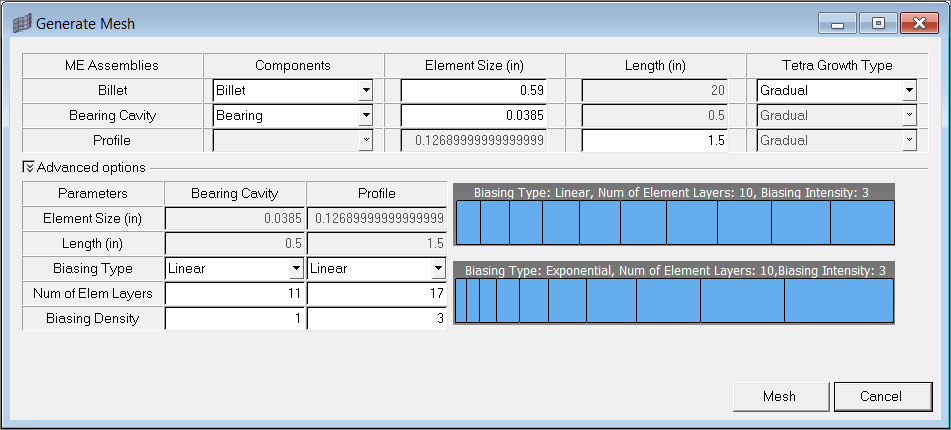
Please see tutorial HX-0100 for explanation of this panel
| 4. | After the mesh is created, click OK to close the dialog. |
| 5. | In the Model browser, observe that three more components are created - Bearing3D, Billet3D and Profile3D. |
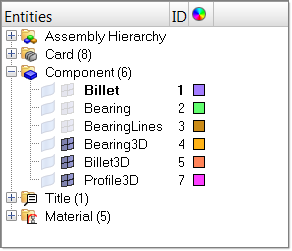
|
| 1. | Return to the Extrusion Wizard and click Generate Workpiece BCs and input parameters as shown below: |
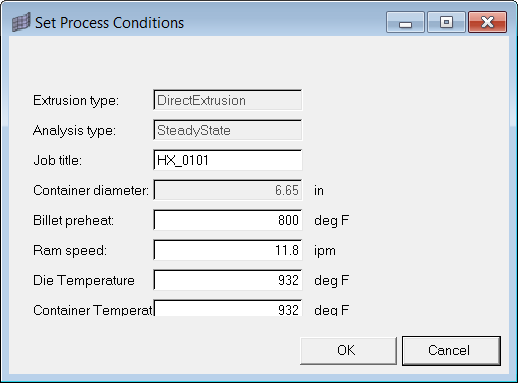
| 3. | In the Model browser notice that related Boundary Conditions components are created. |
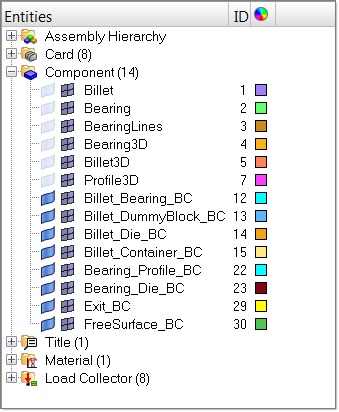
|
| 1. | Click File > Save As… and save the file as HX_0101_FINAL.hm. |
| 2. | Click Save and Export the Model in the Extrusion Wizard. Browse to choose the location and Project file name. |
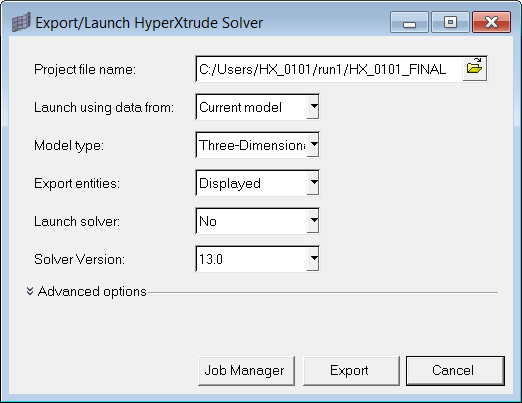
| 3. | Click Export to generate HX_0101_FINAL.grf and HX_0101_final.hx files. |
The .hx and .grf files can be passed to the HyperXtrude solver for computing the solution.
|
Return to Metal Extrusion Tutorials







